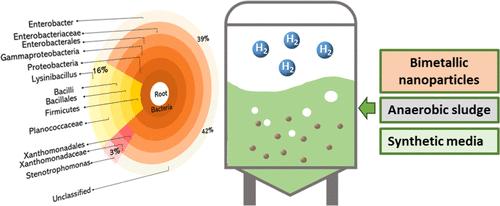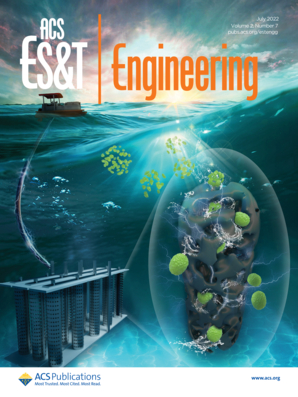Unlocking the Potential of Ni/Fe2O3 Bimetallic Nanoparticles for Fermentative Biohydrogen Production
IF 7.4
Q1 ENGINEERING, ENVIRONMENTAL
引用次数: 0
Abstract
The coordinated system of inorganic nanoparticle-intact living cells has shown great potential in fermentative hydrogen (H2) production. Meanwhile, sluggish electron transfer and energy loss during transmembrane diffusion restrict the production of biohydrogen (BioH2). Herein, iron oxide, nickel oxide, and Ni/Fe2O3 bimetallic nanocomposites were prepared through the coprecipitation method to investigate their potential effect on the dark fermentative hydrogen production (DFHP) system. The results showed that BioH2 production could be enhanced by using nickel and iron oxide composites in DFHP, surpassing the performance of individual iron oxide or nickel oxide and their physical mixture. Specifically, Ni/Fe2O3-5% added to the feed at 150 mg/L increased the BioH2 yields by 51.24% compared to that in its controlled experiment. The microbial community analysis confirmed a significant change in compositional proportions of the microbiome structure of DFHP in response to Ni/Fe2O3-5 wt %. The Enterobacter species proportions increased from 32.0% to 39.0%, along with some unclassified genera of microbial communities, from 34.0% to 42.0%, by supplementation of the nanomaterials. Enterobacter species are versatile facultative hydrogen producers and can use various organic wastes as the sole carbon source. The results suggested that the supplemented Ni/Fe2O3-5% induced the glycolytic efficacy and Fe and Ni availability, thereby increasing the hydrogenase activities. This study provided novel insights into integrating Ni/Fe2O3 into the DFHP system and depicted its potential as an excellent catalyst to increase BioH2 production. The distinctive microbial communities, unidentified hydrogen-producing bacteria, and increased BioH2 yield due to the presence of Ni/Fe2O3 in the DFHP system suggest unique and substantial advantages for the sustainable use of bimetallic nanomaterials in fermentation technology.

发掘 Ni/Fe2O3 双金属纳米颗粒在发酵法生物制氢中的潜力
无机纳米粒子-接触活细胞的协调系统在发酵制氢(H2)方面显示出巨大潜力。同时,电子传递迟缓和跨膜扩散过程中的能量损失限制了生物氢(BioH2)的产生。本文通过共沉淀法制备了氧化铁、氧化镍和 Ni/Fe2O3 双金属纳米复合材料,以研究它们对黑暗发酵制氢(DFHP)系统的潜在影响。结果表明,在 DFHP 中使用镍和氧化铁复合材料可以提高 BioH2 的产量,其性能超过单个氧化铁或氧化镍及其物理混合物。具体而言,与对照实验相比,在饲料中添加 150 mg/L 的 Ni/Fe2O3-5% 可使生物二氧化氢产量提高 51.24%。微生物群落分析证实,Ni/Fe2O3-5 重量百分比对 DFHP 微生物群落结构的组成比例有显著影响。添加纳米材料后,肠杆菌的比例从 32.0% 上升到 39.0%,微生物群落中一些未分类的菌属的比例也从 34.0% 上升到 42.0%。肠杆菌是多功能的兼性产氢菌,可以利用各种有机废物作为唯一的碳源。研究结果表明,添加 Ni/Fe2O3-5% 的纳米材料可提高糖酵解效率,增加铁和镍的供应,从而提高产氢酶的活性。这项研究为将 Ni/Fe2O3 整合到 DFHP 系统中提供了新的见解,并描绘了其作为一种优良催化剂提高 BioH2 产量的潜力。由于在 DFHP 系统中存在 Ni/Fe2O3,因此微生物群落、未识别的产氢细菌以及 BioH2 产量的增加都各具特色,这表明双金属纳米材料在发酵技术中的可持续使用具有独特而巨大的优势。
本文章由计算机程序翻译,如有差异,请以英文原文为准。
求助全文
约1分钟内获得全文
求助全文
来源期刊

ACS ES&T engineering
ENGINEERING, ENVIRONMENTAL-
CiteScore
8.50
自引率
0.00%
发文量
0
期刊介绍:
ACS ES&T Engineering publishes impactful research and review articles across all realms of environmental technology and engineering, employing a rigorous peer-review process. As a specialized journal, it aims to provide an international platform for research and innovation, inviting contributions on materials technologies, processes, data analytics, and engineering systems that can effectively manage, protect, and remediate air, water, and soil quality, as well as treat wastes and recover resources.
The journal encourages research that supports informed decision-making within complex engineered systems and is grounded in mechanistic science and analytics, describing intricate environmental engineering systems. It considers papers presenting novel advancements, spanning from laboratory discovery to field-based application. However, case or demonstration studies lacking significant scientific advancements and technological innovations are not within its scope.
Contributions containing experimental and/or theoretical methods, rooted in engineering principles and integrated with knowledge from other disciplines, are welcomed.
 求助内容:
求助内容: 应助结果提醒方式:
应助结果提醒方式:


